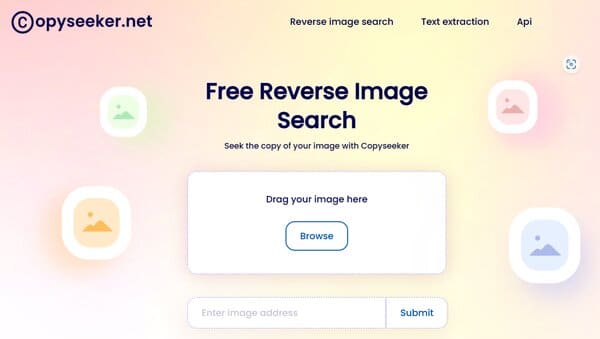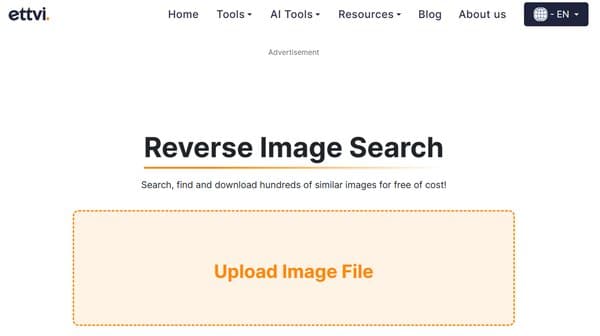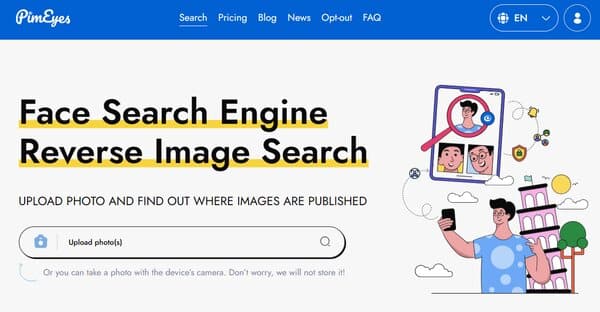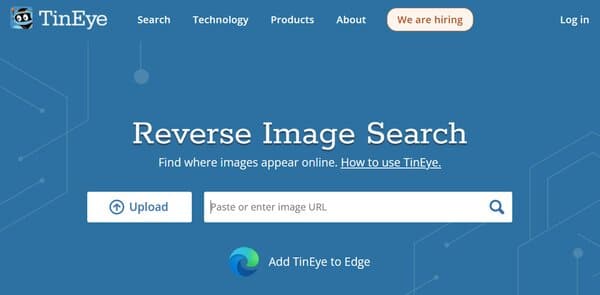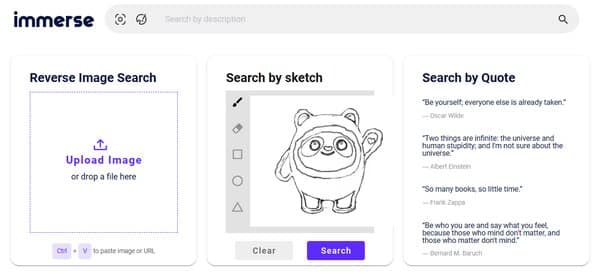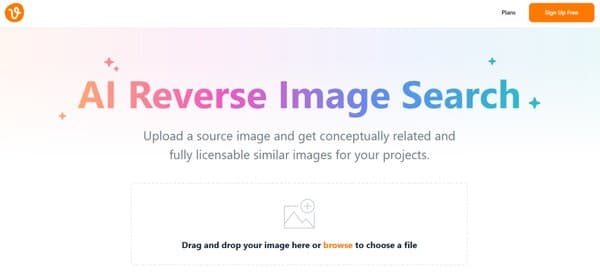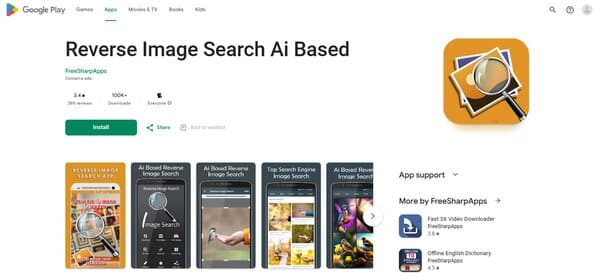7 Best AI Reverse Image Search
AI Reverse Image Search
AI reverse image search technology has revolutionized the way we interact with digital content, offering a seamless method to locate and identify images across the internet. This technology utilizes advanced algorithms powered by artificial intelligence to analyze an image and return results that are visually similar or related. AI reverse image search is particularly valuable in various sectors including digital marketing, copyright protection, and online retail, where visual content plays a crucial role. By enabling users to find the source of an image, discover similar images, or track where an image is used on the web, AI reverse image search enhances digital literacy and fosters a more interconnected online community.
The integration of AI in reverse image search tools has significantly improved their efficiency and accuracy. Traditional image search methods relied heavily on metadata and text descriptions, which often led to irrelevant results. However, AI reverse image search bypasses these limitations by analyzing the visual elements of the image itself—such as colors, shapes, and textures. This not only provides more accurate results but also facilitates a deeper understanding of the content, helping users to make informed decisions about the use of digital images. The technology’s ability to process vast amounts of visual data quickly makes it an indispensable tool for professionals across various industries.
The Need for AI Reverse Image Search
The need for AI reverse image search stems from the exponential growth of digital content and the increasing importance of visual media on the internet. As the digital landscape expands, the volume of images shared online continues to grow at an unprecedented rate. This surge highlights the necessity for efficient tools that can navigate this vast visual space. AI reverse image search addresses this need by providing a powerful solution for managing and sifting through countless images, enabling users to pinpoint specific content amidst the clutter.
Moreover, the digital age has seen a rise in copyright infringement issues, where images are often used without proper authorization or attribution. AI reverse image search plays a critical role in copyright enforcement by allowing creators and copyright holders to track the usage of their images and ensure they are credited appropriately. This technology is also crucial for businesses that rely on maintaining a strong visual brand identity. It helps in monitoring how images associated with a brand are being used online, ensuring that the visual representation remains consistent and is not used in a damaging context.
In the realm of e-commerce, AI reverse image search enhances the shopping experience by allowing consumers to search for products using images. This is particularly useful when customers are looking for items like something they have seen but do not have the words to describe. By simply uploading an image, they can find similar or identical products, making shopping more intuitive and less time-consuming. This capability not only improves customer satisfaction but also drives sales by making it easier for customers to find what they are looking for.
Furthermore, in sectors such as education and research, AI reverse image search facilitates access to information and educational resources. Researchers can use this technology to find academic papers, historical images, or scientific diagrams that are visually similar to their query image. This application of AI reverse image search is transforming how educational content is accessed and utilized, promoting a more dynamic and interactive learning environment.
Overall, the need for AI reverse image search is driven by the demands of a digital-first world where images are central to communication, commerce, and information exchange. As technology continues to evolve, the capabilities of AI reverse image search will expand, further integrating this tool into the fabric of digital interactions and making it a fundamental component of the online experience.
7 Best AI Reverse Image Searchs
- Copyseeker
- ettvi Reverse Image Search
- PimEyes
- TinEye
- Immerse.zone
- Vecteezy AI Reverse Image Search
- Reverse Image Search AI Based
How does AI Reverse Image Search work?
AI reverse image search utilizes advanced machine learning and computer vision technologies to analyze and identify images. When an image is uploaded into a reverse image search engine, the AI first processes the image by extracting key features such as colors, textures, shapes, and patterns. This process involves creating a digital fingerprint or a unique code that represents the image. The AI then compares this fingerprint against a vast database of indexed images to find matches or similar images.
The effectiveness of AI in reverse image search lies in its ability to learn and improve over time. Through machine learning algorithms, the system continuously learns from new data, enhancing its ability to recognize and match images accurately. This capability allows it to identify not just identical copies but also images that are visually similar, even if they have been altered or are presented in different contexts.
How to choose an AI Reverse Image Search?
Choosing the right AI reverse image search tool involves considering several key factors that can affect the performance and suitability of the tool for your specific needs. One of the primary considerations is the accuracy of the tool. The AI should be capable of delivering precise results even when the images have variations such as different angles, lighting, or modifications.
Another important factor is the speed of the search process. Efficient AI tools can quickly scan through extensive databases and return results in real-time, which is crucial for applications that require immediate responses, such as content moderation or digital asset management.
The size of the image database that the AI reverse image search tool can access also plays a critical role. A larger database increases the likelihood of finding a match or relevant images. Therefore, opting for a tool that has access to extensive image repositories can significantly enhance the effectiveness of the search.
Additionally, the ease of integration into existing systems is an important consideration. The AI reverse image search tool should be compatible with your current digital infrastructure, allowing for seamless integration without requiring extensive modifications or technical adjustments.
Finally, privacy and security features are essential, especially when dealing with sensitive or proprietary images. Ensure that the AI tool provides robust security measures to protect your data and comply with relevant regulations and standards.
By carefully evaluating these factors, you can select an AI reverse image search tool that meets your requirements and enhances your ability to utilize visual content effectively.
Reverse Image Search AI
1. Copyseeker
Copyseeker is an advanced AI reverse image search platform designed to enhance the way users interact with digital imagery on the internet. By leveraging cutting-edge artificial intelligence, Copyseeker offers a sophisticated solution for identifying, analyzing, and tracking images across the web. This tool is particularly useful for professionals and individuals alike who seek to verify the authenticity of images, find visually similar content, or protect their digital assets from unauthorized use. With its user-friendly interface and robust technology, Copyseeker simplifies the process of reverse image searching, making it accessible and efficient for users of all skill levels.
What does Copyseeker do?
Copyseeker is an AI reverse image search that operates as a comprehensive reverse image search tool that utilizes artificial intelligence to scan the internet for duplicates or similar versions of a given image. This functionality is invaluable for a variety of purposes, including copyright protection, digital marketing, and online investigation. Whether you’re a photographer looking to track the usage of your work, a marketer seeking inspiration, or an individual trying to identify the source of an image, Copyseeker provides detailed insights and results. It goes beyond simple image recognition by understanding the context and details of images, thereby offering more accurate and relevant search outcomes. Additionally, Copyseeker aids in safeguarding users’ visual content by alerting them to potential unauthorized use and facilitating the process of acting against copyright infringements.
Copyseeker Key Features
Advanced AI Algorithms: Copyseeker’s core strength lies in its sophisticated artificial intelligence algorithms that analyze images with remarkable accuracy. These algorithms are capable of recognizing not just the image itself but also its context, ensuring that users receive the most relevant search results.
Chrome Extension for Easy Access: Enhancing user convenience, Copyseeker offers a dedicated Chrome extension. This feature allows users to perform reverse image searches directly from their browser, streamlining the process and saving valuable time.
Custom GPT Model for Enhanced Searches: To further refine search capabilities, Copyseeker incorporates a custom GPT model. This addition boosts the platform’s ability to understand and interpret images, leading to more precise and comprehensive search outcomes.
Duplicate Detection: A key feature of Copyseeker is its ability to detect potential duplicates of an image. This is particularly useful for content creators and copyright holders who wish to monitor the web for unauthorized use of their visual assets.
Filtering Out Low-Quality Sites: Copyseeker enhances the quality of search results by filtering out low-quality websites. This ensures that users are directed to credible sources, improving the overall search experience.
Legal Support for Image Rights: Understanding the importance of legal protection, Copyseeker provides tools and resources to help users navigate copyright issues. This includes assistance in ensuring proper image use rights and support in addressing copyright infringements.
Continuous Monitoring: For users concerned about the ongoing use of their images, Copyseeker offers continuous monitoring services. This feature alerts users to new instances of their images appearing online, allowing for timely action against unauthorized use.
2. ettvi Reverse Image Search
ettvi Reverse Image Search is a sophisticated tool designed to enhance the way users interact with digital images. Utilizing content-based image retrieval technology, this platform allows individuals to upload an image and quickly locate similar or derivative images across the web. It’s particularly useful for identifying the source of an image, finding higher quality versions, and discovering where an image is being used online. The AI reverse image search is accessible without any subscription fees, offering unlimited searches that cater to both casual users and professionals who need to track image usage and authenticity.
What does ettvi Reverse Image Search do?
ettvi Reverse Image Search serves as a dynamic resource for anyone looking to delve deeper into the digital imagery world. By simply uploading an image or entering a related keyword, users can initiate a search that scans the internet for images that are visually similar or related. This AI reverse image search is invaluable for photographers, content creators, and marketers who need to trace the origin of an image, assess its usage across different platforms, or even locate the creator of the image. It’s also beneficial for legal professionals and copyright holders interested in monitoring the distribution and unauthorized use of their visuals.
ettvi Reverse Image Search Key Features
Similar Image Lookup: This feature allows users to find thousands of images that are similar or related to the one they have uploaded. It’s particularly useful for discovering how widely an image has been shared or modified across the internet.
Advanced Visual Search: By entering a sample image or keyword, users can explore a vast array of visuals that share similarities with the input. This is ideal for those looking to compare image quality or find different versions of the same image.
Free Unlimited Access: One of the standout features of ettvi Reverse Image Search is its accessibility. Users can perform unlimited searches without any cost, making it an excellent tool for both personal and professional use.
3. PimEyes
PimEyes is an advanced online AI reverse image search that leverages artificial intelligence to perform reverse image searches specifically focused on facial recognition. This platform scans the internet to locate images that match the facial features of the uploaded photos. It is designed to help users monitor where their images appear online and manage their digital identity effectively. PimEyes serves a broad audience, from individuals concerned about personal image misuse to professionals in fields like public relations and law enforcement seeking to track the digital footprint of persons of interest.
What does PimEyes do?
PimEyes is an AI reverse image search that operates by allowing users to upload a photograph, after which it uses facial recognition technology to search through countless online sources for similar facial images. This functionality is crucial for identifying instances where a person’s image might be used without their permission, potentially leading to identity theft or reputation damage. The tool is particularly useful for discovering unauthorized uses of one’s images on various websites across the internet, excluding social media platforms. It provides a proactive approach to personal and professional reputation management online.
PimEyes Key Features
Facial Recognition Search: PimEyes excels in its core functionality of facial recognition, which allows it to perform precise searches by analyzing the facial features in an uploaded image and matching them with faces in images found online.
Alerts System: This feature notifies users whenever new images matching their facial profile are uploaded to the internet, helping them stay informed about their online presence.
Image Privacy Protection: PimEyes offers tools for users to act if their images are found on sites without their consent, including options for initiating takedown requests to help manage and protect their online identity.
Advanced Search Options: Users can refine their searches with advanced filters to increase the accuracy and relevance of search results, ensuring that the findings are as precise as possible.
Subscription Plans: PimEyes provides various subscription levels, offering more features and capabilities at higher tiers, such as increased search limits and more comprehensive monitoring tools.
4. TinEye
TinEye is a sophisticated reverse image search engine that leverages advanced image recognition technologies to provide unique search capabilities. Unlike traditional search engines that rely on text queries, TinEye allows users to upload an image and find where it appears on the web or discover altered versions of the image. This AI reverse image search is particularly useful for photographers, copyright holders, and marketers who need to track the usage and distribution of their images online. TinEye’s technology does not rely on metadata or image names but uses a digital fingerprint of the image to perform searches across its vast database.
What does TinEye do?
TinEye is an AI reverse image search that enables users to conduct reverse image searches by creating a unique digital signature for each image submitted. This signature is then compared against billions of other images indexed in TinEye’s database to find exact matches or modified versions of the original image. This functionality is crucial for identifying copyright infringements, detecting fraudulent use of images, and verifying the authenticity of images found online. TinEye supports various methods for image search, including direct uploads, URL submissions, and drag-and-drop options, making it accessible and easy to use for diverse user needs.
TinEye Key Features
Image Recognition Technology: TinEye uses proprietary algorithms to analyze images and create unique identifiers or ‘fingerprints’. This technology enables the engine to find exact matches and visually similar images across the internet, even if they have been cropped, edited, or resized.
Visual Search: This feature allows users to search for images using images instead of words. It is particularly useful for finding the source of an image, locating higher resolution versions, or identifying other uses of the same image across the web.
Browser Extensions: TinEye offers browser extensions for Chrome, Firefox, and Opera, which simplify the process of conducting reverse image searches. Users can right-click on any image they find online and search for it directly without navigating away from their current page.
Privacy and Security: TinEye prioritizes user privacy by not storing images that are uploaded for searching. Once the search is complete, the images are discarded, ensuring that users’ content remains private and secure.
API Access: For developers and businesses, TinEye provides an API that can be integrated into other applications or websites. This allows for automated reverse image searches and adds image search functionality to third-party platforms.
5. Immerse.zone
Immerse.zone is an advanced AI-powered reverse image search engine that utilizes cutting-edge technology to provide insightful and accurate image search capabilities. This AI reverse image search is designed to cater to a wide range of users, from digital marketers and content creators to researchers and the public, offering a user-friendly interface that simplifies the process of finding similar images or identifying the content of a given image. By leveraging artificial intelligence, Immerse.zone delivers a more nuanced understanding of images compared to traditional keyword-based search engines, making it a valuable tool in the digital age.
What does Immerse.zone do?
Immerse.zone is an AI reverse image search that operates as a multi-modality reverse image search engine that excels in analyzing and understanding images at a deeper level. Unlike conventional search engines that rely heavily on metadata and keywords, Immerse.zone uses AI to interpret the context and elements within images, providing users with highly relevant search results. This capability is particularly useful for professionals in various fields who require precise image searches to gather visual data, verify image authenticity, or find inspiration for creative projects. The platform supports uploads directly from users, allowing for a personalized search experience that caters to specific needs and preferences.
Immerse.zone Key Features
Visual Recognition: This feature allows Immerse.zone to identify and analyze the components of an image, such as objects, scenes, and even emotions, providing a comprehensive breakdown of its content. This is particularly useful for users who need to understand or categorize images based on visual data rather than text descriptions.
AI-Driven Contextual Understanding: Immerse.zone employs advanced algorithms to understand the context surrounding an image. This means that the search results are not only based on the visual similarity but also on the relevance to the query’s intent, enhancing the accuracy of search outcomes.
User-Friendly Interface: The platform is designed with simplicity in mind, making it accessible to users with varying levels of technical expertise. The straightforward layout ensures that new users can navigate the site easily, making the process of conducting reverse image searches less intimidating.
High-Quality Image Database: Immerse.zone has access to a vast database of high-quality images, which enhances the search accuracy and provides users with a wide variety of image options to choose from. This extensive collection is continuously updated to include the latest images available across the web.
Multi-Modal Search Capabilities: This feature supports searching by image upload, URL input, or direct pasting of images, offering flexibility in how users can initiate their search queries. This adaptability makes Immerse.zone a versatile tool for various use cases, from academic research to commercial image verification.
6. Vecteezy AI Reverse Image Search
Vecteezy AI Reverse Image Search is a cutting-edge tool designed to enhance the experience of finding conceptually related and fully licensable images for various projects. By harnessing the power of extensive search data and incorporating feedback from millions of creative professionals, this platform has developed a sophisticated image identification technology tailored for the stock photography industry. Unlike traditional methods that rely solely on pixels and color, leading to inaccuracies, Vecteezy’s computer vision technology delves into the context of an image, ensuring more relevant and accurate results. The platform also prioritizes user safety by implementing safeguards against offensive imagery, utilizing its proprietary data and machine learning algorithms to refine search outcomes continually.
What does Vecteezy AI Reverse Image Search do?
Vecteezy AI Reverse Image Search offers a unique solution for sourcing images that are conceptually like a user’s input. This AI reverse image search allows users to upload a source image, after which the platform’s advanced computer vision technology analyzes the context and content of the image to return a selection of related images. These results are not only relevant but also fully licensable, making them ideal for creative projects. The technology behind Vecteezy AI Reverse Image Search is designed to overcome the limitations of traditional image search methods, which often result in false positives by relying on basic parameters like pixels and color. Instead, Vecteezy focuses on understanding the deeper context of an image, leading to a more intuitive and satisfying user experience.
Vecteezy AI Reverse Image Search Key Features
Contextual Understanding: Vecteezy AI Reverse Image Search stands out for its ability to grasp the context of an image beyond mere pixels and colors. This feature ensures that the search results are not only visually similar but also conceptually related to the original image, providing a richer pool of options for creative projects.
Fully Licensable Images: One of the key advantages of using Vecteezy AI Reverse Image Search is the access it provides to a vast library of images that are fully licensable. This means users can confidently use the images for their projects without worrying about copyright issues, streamlining the creative process.
Safety Measures: Vecteezy has implemented robust safeguards to prevent offensive or inappropriate imagery from appearing in search results. This commitment to user safety is a testament to the platform’s dedication to creating a positive and secure environment for its users.
Machine Learning Optimization: The platform continuously improves its search capabilities through machine learning, training its models on proprietary data. This ongoing optimization process ensures that Vecteezy AI Reverse Image Search remains at the forefront of image identification technology, offering increasingly accurate and relevant results over time.
Feedback Integration: By incorporating feedback from millions of creative professionals, Vecteezy ensures that its technology meets the real-world needs of its users. This collaborative approach to development allows the platform to refine and enhance its features continually, ensuring they remain aligned with the evolving demands of the creative industry.
7. Reverse Image Search AI Based
Reverse Image Search AI Based is a user-friendly application designed to simplify the process of finding matching images or identifying personalities across the globe. Developed by FreeSharpApps, this tool integrates with major search engines like Google, Bing, Yandex, TinEye, and Lexica (Stable Diffusion) to provide quick and accurate results. The app is particularly useful for verifying the authenticity of images, discovering visual similarities, or identifying the subjects within the photos. It supports searches from various sources including your gallery, camera, or directly via URLs, making it a versatile choice for users ranging from professionals to casual browsers.
What does Reverse Image Search AI Based do?
Reverse Image Search AI Based allows users to upload an image and search for visually similar images or identify who is in the picture using advanced AI technologies. By simply selecting an image from their device, users can initiate a search that taps into powerful AI-based image search engines. This process helps in finding exact matches or related images across the internet, which can be crucial for tasks such as verifying the source of an image, checking for image usage rights, or simply finding higher resolution versions of the same image. The app’s ability to search by image makes it a valuable tool for digital marketers, content creators, and anyone involved in digital media.
Reverse Image Search AI Based Key Features
Ease of Use: The app is designed to be intuitive and straightforward, requiring no advanced technical knowledge to operate.
Multiple Search Engines: It utilizes a combination of several leading search engines, enhancing the breadth and accuracy of search results.
Versatility: Users can search images uploaded from their gallery, taken directly from their camera, or even images found online through URLs.
Speed: The application is optimized for quick searching, providing results in just a few seconds, which is essential for users needing immediate information.
Continuous Development: The app is still evolving, with promises of more advanced features in future updates to enhance user experience and search capabilities.
FAQs on AI Reverse Image Search
What is an AI Reverse Image Search?
AI reverse image search is a technology that allows users to search for information using images instead of words. It employs artificial intelligence and machine learning algorithms to analyze the content of an image and then searches the internet for similar images or related information. This technology is widely used in various fields such as digital marketing, copyright infringement detection, and online shopping, to enhance user experience by providing more accurate and relevant search results. The process involves extracting features from the submitted image, such as colors, shapes, and textures, and comparing these features against a vast database of indexed images. The AI algorithms then identify matches or related content, offering users a way to discover where an image came from, find higher resolution versions, or locate visually similar images.
How does AI Reverse Image Search work?
The working mechanism of AI reverse image search involves several complex steps powered by artificial intelligence. Initially, when an image is uploaded for a search, the AI analyzes the image to identify its key features, which include patterns, colors, shapes, and other visual markers. This analysis is done using convolutional neural networks (CNNs), a type of deep learning algorithm specifically designed for processing visual data. Once the features are extracted, the AI compares them against a pre-existing database of images. This comparison is not a simple one-to-one match but involves understanding the context and the content of the images. The AI uses similarity metrics to find images that are not just identical but also similar in context or appearance. The results are then ranked based on relevance, and the most relevant images are displayed to the user. This technology is constantly evolving, with algorithms becoming more sophisticated in understanding and interpreting images in a way that mimics human visual perception.
What are the applications of AI Reverse Image Search?
AI reverse image search has a wide range of applications across various industries. In digital marketing, it helps brands monitor where and how their images are being used online, ensuring copyright compliance, and enhancing brand visibility. In e-commerce, customers can use reverse image search to find products by uploading pictures, making shopping more intuitive and efficient. In the field of copyright and intellectual property, it aids in detecting unauthorized use of images, helping creators and copyright owners protect their work. Additionally, in the realm of content creation and journalism, journalists and researchers can use reverse image search to verify the authenticity of images, track the source of an image, and uncover the context behind it. Furthermore, in education and research, this technology assists in finding educational content, scientific diagrams, and historical images, enriching learning materials and research documents.
What are the challenges faced by AI Reverse Image Search?
Despite its numerous benefits, AI reverse image search faces several challenges. One of the primary challenges is the issue of privacy and security. As users upload images to search engines, there is a risk of sensitive or personal information being exposed. Ensuring the privacy of users and the security of the data becomes paramount. Another challenge is the accuracy of search results. The effectiveness of reverse image search depends on the quality and size of the image database, as well as the sophistication of the AI algorithms. Misinterpretations and inaccuracies can occur, leading to irrelevant or incorrect search results. Additionally, copyright infringement is a concern, as the technology can inadvertently facilitate the unauthorized use of copyrighted images. Lastly, the technology requires significant computational resources for processing and analyzing images, which can be a limitation for scaling and improving the service.
Conclusion
AI reverse image search represents a significant advancement in how we interact with digital content, offering a more intuitive and efficient way to navigate the vast expanse of the internet using visual cues. Its applications span various sectors, providing valuable tools for digital marketing, e-commerce, copyright protection, content verification, and more. However, as with any technology, it faces challenges that need to be addressed, including privacy concerns, accuracy of results, copyright issues, and the need for substantial computational resources. Despite these challenges, the future of AI reverse image search looks promising, with ongoing advancements in AI and machine learning expected to enhance its capabilities and applications further. As we continue to integrate this technology into our digital lives, it will undoubtedly open up new possibilities for accessing and understanding the world around us through the lens of visual search.
Related Read:

